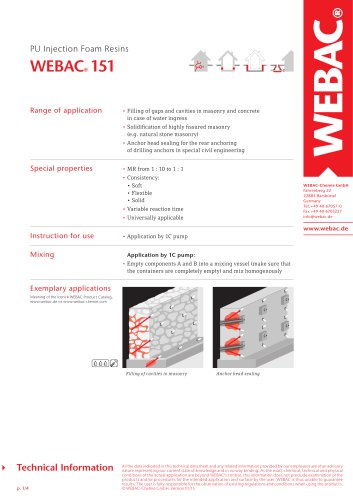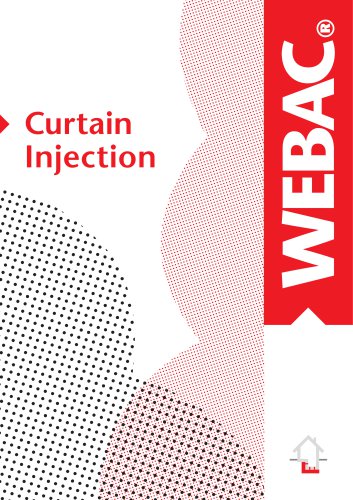
Catalog excerpts
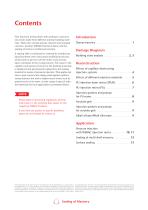
Contents This brochure mainly deals with sealings in masonry structures made from different mineral building materials. These also include porous concrete and stamped concrete. Another WEBAC Brochure deals with the sealing of cracks in reinforced concrete. A sealing effect is obtained or restored by introducing liquid synthetic resin into porous building structures, which forms a barrier over the entire cross section upon conclusion of the curing process. The water in the capillary and porous structure of the building materials is displaced and permanently replaced by the sealing material...
Open the catalog to page 2
Damp Masonry More than a visual shortcoming – moisture-related damage to plinths and basement walls is one of the most common building defects in structural engineering. This damage can have different causes. Moisture-damaged masonry Structural components with ground contact are exposed to varying moisture stresses such as seepage water, soil moisture and ground water. Plinth areas are also exposed to stress caused by splashing water, ice, de-icing salt, etc. and to thermal stresses due to temperature fluctuations. Professionally designed buildings are provided with sealings which prevent...
Open the catalog to page 3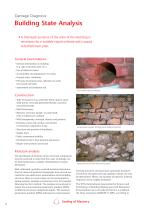
Damage Diagnosis Building State Analysis A thorough analysis of the state of the building is necessary for a suitable repair scheme and a sound refurbishment plan. General examinations • General information on building (e.g. age, structural state, etc.) • Use of adjacent rooms • Air humidity and temperature in rooms • Ground water conditions • PH value of ground water, reference to acids (increased salt load) • Assessment of foundation soil Core removal from brickwork Construction • Type of masonry (e.g. sand-lime brick, quarry stone, solid bricks, vertically perforated bricks, concrete,...
Open the catalog to page 4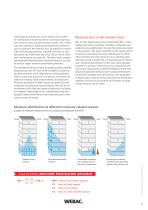
which injection materials can be tested and certified. In combination with pressureless or pressure injection, six variations arise for effectiveness checks. For certain injection materials, additional pretreatment measures such as drying of the masonry (e.g. for paraffin or certain alkali silicate preparations), alkaline activation or reaction phase up to the water load (e.g. silicon micro-emulsion concentrates) are required. Thanks to such complex pretreatment measures these injection materials can also be used at higher moisture penetration gradients. The alternative test proc edure...
Open the catalog to page 5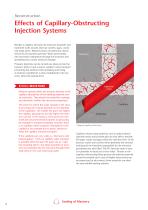
Effects of Capillary-Obstructing Injection Systems Besides a capillary network, the structure of plinths and basement walls usually also has cavities, gaps, cracks and large pores. Masonry joints are generally characterized by the greatest porosity. Water penetrating into structural components through this structure and spreading thus causes moisture damage. Masonry joint Pressure injections can be carried out, above all into the masonry joints, to put a stop to capillary water transport preventing the moisture from spreading and rising. A moisture equilibrium is then established in the...
Open the catalog to page 6
Effects of Different Injection Materials The injection material spreads away from the drill hole into the joints and bricks, fi rst fi lling large openings such as cracks and gaps. The material then penetrates capillaries and pores and more and more fi ne structures. Under pressure, damp areas and areas fi lled with water are penetrated and the water is partly displaced from the structure. The effects of different injection materials are illustrated (standing below). The capillary/pore structure is entirely fi lled, putting a stop to all capillary water transport in the long term,...
Open the catalog to page 7
Products The success of an effective damp-proof course (dpc) mainly depends on the selection of the right injection material. A description of WEBAC Products and their areas of application and properties is given below. PU Injection Foam Resins (SPU) Quick-foaming polyurethane injection foam resins (SPU) are specially designed to fill the essential parts of masonry full of gaps and cavities. Upon contact with water, the resins form a foam of fine cellular structure during a very quick reaction which fills all free volumes and also displaces the water from the building structure. Thanks to...
Open the catalog to page 8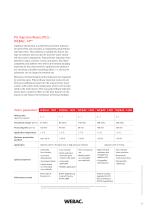
PU Injection Resins (PU) – WEBAC 14** ® Capillary obstruction is achieved by pressure injection of solvent-free, low-viscosity, 2-component polyurethane injection resin. This material is suitable for almost any type of masonry and can also be used for water-satu a r ted structural components. Polyurethane injection resin spreads in gaps, cavities, cracks and pores, fills these completely and adheres very well to the mineral building materials.At the same time the capillaries are obstructed, ensuring a durable insulating effect, i.e. the active substance can no longer be washed out....
Open the catalog to page 9
Products PU Injection Resins (PUR) – WEBAC 16** Injection pumps for PU resins When applying PU injection resin using single-component pumps, both components are mixed beforehand and then filled into the pump‘s hopper. For surface injections within the masonry structure, a stabiizing effect can be obtained in addition to the seal l ing effect when filling cavities. The polyurethane re ins s described above (WEBAC 14**) are used for sealing structures against moisture and have only secon dary sealing properties. The new generation of compression-proof polyurethane resins, WEBAC 1610 and...
Open the catalog to page 10
Acrylate gels Alkali silicate/Alkali siliconate Acrylate gels are usually aqueous 3C Injection Materials with a very low viscosity of < 10 mPa·s. The materials are particularly suitable for thick structural components and obstruct the capillaries in the masonry like PU injection resins. They can also be used in case of salt-related stress and high moisture penetration gradients. Acrylate gels are applied by means of pressure injection with a 2C Pump and are also suitable for surface sealings within open-pored building structures. The material can rever sibly absorb and discharge water and...
Open the catalog to page 11


